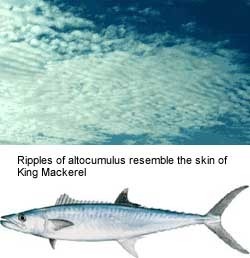Where’s The Weather?

(John Quill of Channel 22 – WWLP, Springfield, Mass – the source of my boyhood weather info…although notice the lack of specificity)
A well-known song heard along the waterfront includes the line The Weather Is Here. Unfortunately, that has not been the case for the Summer of 2013.
We’ve had a disproportionate share of bad weather across the lower 48 and that’s not even getting into a discussion about wild fires in the west. No less frustrating has been the lack of predicable forecasts. In fact, when we’ve had good days they’ve tended to come as unexpected surprises.
For those of us on the water, more time has been spent reading near-time info such as regional radar maps and electronic buoy data. The old weather proverbs have been helpful, too. You know:
Red sky in the morning, sailor take warning
Red sky at night sailor’s delight,
When the windows won’t open and the salt clogs the shaker,
The weather will favor the umbrella maker.
Mackerel sky, 24 hours dry.
There’s science to support these old adages (or at least that’s what Wikipedia says and good old Wiki is, after all, no less reliable than your smartest friend).


But this is the 21st century. Shouldn’t technology provide us with forecasts that are superior to lore passed down from 19th century mariners? The answer is an emphatic Yes.
Data scientists are using the tools of physics, statistical modeling, and supercomputing to develop advanced weather forecasting tools. As reported in Computerworld magazine, the National Oceanic and Atmospheric Administration (NOAA) has switched on two new supercomputers that are expected to improve weather forecasts. These two new computer systems are 213-teraflop machines and the government expects an increase in accuracy of no less than 15%.
But wait a minute, isn’t the common observation reported at the opening of this blog recognition that we’ve experienced really bad forecasts as of late? And by the way, what’s a teraflop?
My smart friend, Wiki, tells me that tera means trillion, as in one thousand billion, and a tera flop is equal to one trillion flops per second. Or, in this case, 213 trillion flops per second.
What? Flops? I am fairly certain we can all agree that the federal government is quite capable of creating flops with great ease, so now we’re adding supercomputing power to these folks so they can generate trillions of flops per second?
The answer is yes, but don’t worry. That really smart friend who has already received too much recognition tells me that a flop is a type of arithmetic calculation. The folks at NOAA are able to pump all kinds of weather data into these machines and make massive calculations to create weather modeling never before imagined. This is a real-world application of big-data that we’ve been hearing about, and I, for one, welcome this type of government R&D.
But, for a brief moment, let’s get back to that figure of 213 trillion computations per second. Where are they possibly getting that staggering amount of data?
Hmmm. Wait a minute, is it possible that the NSA is sending NOAA our emails, texts, voicemails, and smartphone photos to load them up on the weather Supercomputer? With 316 million people in the US and 7.1 billion around the globe, there’d be a treasure trove of GPS-identified weather photos, don’t you think? And consider how much idle chitchat we do texting and talking about the weather.
But let’s not get cynical. So far, Fox and CNN haven’t broken news of a National Weather Service contractor holding out in a Russian airport. Until they do, I am going to be looking to the sky, checking the salt shaker, and hoping that 213 trillion flops a second soon gives me a better window on the best time to set sail.
John Urban
Share on Facebook



